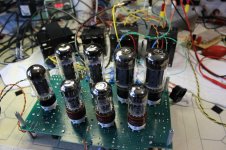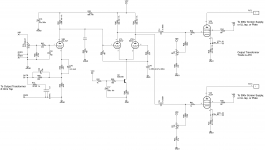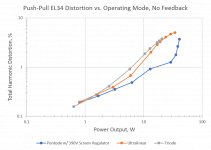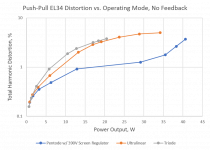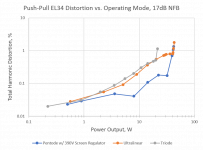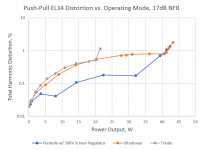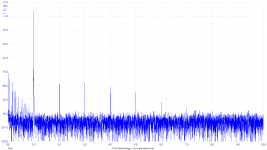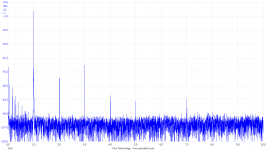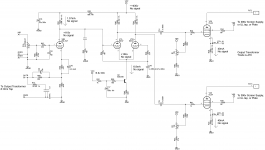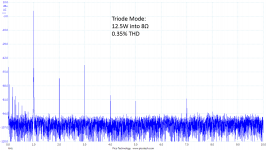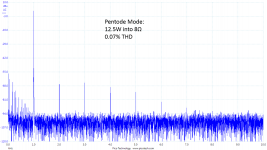This project began when I built a prototype of a simple push-pull amplifier using 7591A tubes. I planned to operate the tubes in “ultralinear” (UL) mode, but discovered that they had much lower distortion when operated as pentodes. I was surprised, but attributed it to unique behavior of the 7591A.
I built a second prototype of my amplifier that could use either push-pull EL34 or 6L6GC, to compare with my 7591A prototype. I measured the distortion performance of the EL34s in pentode mode (with a regulated 390V screen supply), UL mode, and triode mode. Once again, the EL34s have much lower distortion in pentode mode, higher distortion in UL mode, and highest in triode mode. I expected lower power from triodes, but not higher distortion.
The schematic shows all components on the PCB. The output transformer is a Triode Electronics A-470 (4300Ω primary Z with 43% UL taps), the plate voltage is 440-450V no signal, dropping to 410V at full signal. I measured THD at 1kHz, both with no global feedback, and also with a constant 17dB global feedback from the 8Ω secondary. Since the output stage gain varies with operating mode, Rfb is changed to maintain 17dB NFB. The two plots compare THD in pentode mode, UL mode, and triode mode, with and without global feedback. I’ve plotted the same data on both log-log and log-linear scales, to emphasize different portions of the power spectrum.
So, does anyone in the diyaudio community have insight into this, or an explanation? Has anyone else made measurements like this, comparing these modes of operation? I had always thought that connecting a power pentode or beam power tube as a triode was supposed to give lower distortion. But I’m quite confident of these measurements. If low distortion is a goal, UL or triode operation does not appear to be effective.
Scott
I built a second prototype of my amplifier that could use either push-pull EL34 or 6L6GC, to compare with my 7591A prototype. I measured the distortion performance of the EL34s in pentode mode (with a regulated 390V screen supply), UL mode, and triode mode. Once again, the EL34s have much lower distortion in pentode mode, higher distortion in UL mode, and highest in triode mode. I expected lower power from triodes, but not higher distortion.
The schematic shows all components on the PCB. The output transformer is a Triode Electronics A-470 (4300Ω primary Z with 43% UL taps), the plate voltage is 440-450V no signal, dropping to 410V at full signal. I measured THD at 1kHz, both with no global feedback, and also with a constant 17dB global feedback from the 8Ω secondary. Since the output stage gain varies with operating mode, Rfb is changed to maintain 17dB NFB. The two plots compare THD in pentode mode, UL mode, and triode mode, with and without global feedback. I’ve plotted the same data on both log-log and log-linear scales, to emphasize different portions of the power spectrum.
So, does anyone in the diyaudio community have insight into this, or an explanation? Has anyone else made measurements like this, comparing these modes of operation? I had always thought that connecting a power pentode or beam power tube as a triode was supposed to give lower distortion. But I’m quite confident of these measurements. If low distortion is a goal, UL or triode operation does not appear to be effective.
Scott
Attachments
Very interesting. I'll watch this thread
It _could_ be repeated with a concertina as phase inverter. If time allows of course.
Or some adjustment for AC balance.
BTW, is the tubes matched ? If so how close Gm ?
It _could_ be repeated with a concertina as phase inverter. If time allows of course.
Or some adjustment for AC balance.
BTW, is the tubes matched ? If so how close Gm ?
Last edited:
I would be interested at the same plots, but rather "THD vs input voltage" than "THD vs output power" 😎
Compared to Marantz 8B , similar circuit , your amp with feedback has very high distortion in UL. May be the distortion of the precedent stages is subtracting with output's in pentode but adding with the other modes. Measuring the distortion in differential mode at the grids of the outputs in open loop can give some clarity.
That's really interesting I cannot see that UL does not work, but your results are very convincing.
Is it mainly 3'rd harmonic you see. If you could rule out the phase splitter by measuring the distortion at its output just in case as Kokoriantz said you have some funny cancellation going on. I myself would try a simulation to see if the results match.
What of the values of Vcc and Vpp so we know the operating point? I would say that because you are operating the grid of V1a and V1b at something like Vpp * .4 you will be limiting the linearity of the stage and the available plate swing will be small but thats just a guess.
Is it mainly 3'rd harmonic you see. If you could rule out the phase splitter by measuring the distortion at its output just in case as Kokoriantz said you have some funny cancellation going on. I myself would try a simulation to see if the results match.
What of the values of Vcc and Vpp so we know the operating point? I would say that because you are operating the grid of V1a and V1b at something like Vpp * .4 you will be limiting the linearity of the stage and the available plate swing will be small but thats just a guess.
Last edited:
The bit of info your missing is what is the harmonic content. A triode OP stage will have more THD, but it'll be mostly 2H. Pentode mode will give more 3H, UL in between the two. Looking at a THD meter or graph doesn't tell you the whole story.
Andy.
Andy.
The bit of info your missing is what is the harmonic content. A triode OP stage will have more THD, but it'll be mostly 2H. Pentode mode will give more 3H, UL in between the two. Looking at a THD meter or graph doesn't tell you the whole story.
Andy.
I think that's SE not PP. PP should when balanced will generate only odd harmonics into speaker load.
Could the results be caused by the fact that you use fixed bias?
Maybe pages 3 to 10 of this book are usefull: http://www.introni.it/pdf/Rodenhuis%20-%20HiFi%20Circuits.pdf
Maybe pages 3 to 10 of this book are usefull: http://www.introni.it/pdf/Rodenhuis%20-%20HiFi%20Circuits.pdf
"PP should when balanced will generate only odd harmonics into speaker load." Not in my experience. Harmonic content of OP stages is more complex, more nuanced.
Andy.
Andy.
"PP should when balanced will generate only odd harmonics into speaker load." Not in my experience. Harmonic content of OP stages is more complex, more nuanced.
Andy.
True, but if the circuit is completely symmetric with symmetric drive and identical valves etc, then the even harmonics cancel in the output stage. That's just maths. In practise the 2nd harmonic will be 10dB down on the third. I like amps that don't introduce distortion (blameless) but some would say even harmonics sound good. If there is lots of second harmonic in a PP output stage then one side is working harder than the other.
Could the results be caused by the fact that you use fixed bias?
Maybe pages 3 to 10 of this book are usefull: http://www.introni.it/pdf/Rodenhuis%20-%20HiFi%20Circuits.pdf
Would think that would come into play at larger output power. I suppose the cathode caps could add distortion too.
Thanks for all the comments. I’ve added some more data to the schematic, with voltages and currents for the driver stage. I haven’t measured distortion for the driver stage alone, but I verified that it is capable of linearly swinging more than ±75V at the EL34 grids (if the EL34s are removed). I doubt that driver stage distortion is contributing much to the overall distortion, or canceling much. But I’ll look into a way of measuring the differential distortion at the EL34 grids. I don’t have a differential probe, so this may take a while.
The EL34s are brand new, Apex-matched Mullard Reissue EL34, the same for all tests. They are biased at 40mA quiescent current, which equates to a grid voltage of -34V in pentode mode and -40V in UL or triode mode.
All distortion measurements were taken with a PicoScope 4262 in spectrum analyzer mode, so I actually looked at the distortion spectrum for every data point I took. I posted a couple of typical plots, one for triode mode, one for pentode mode. These were taken at 10v RMS output into 8 ohms (12.5W), with 17dB NFB. You can see that the triode mode distortion is not only much higher, but has a greater proportion of 3rd and 7th harmonics.
I don’t have a Marantz 8B that I can measure for comparison………… But I think my open loop UL-mode measurements are fairly typical for a pair of EL34s. For instance, look at measurements made at 1kHz on the Jadis Orchestra Black in the April 2020 issue of Stereophile (that amp uses a small amount of NFB, I’m not sure how much). I'll see if I can find other reliable data on UL mode EL34 amps.
My intention in posting this data was not to create controversy. I was surprised and puzzled at the poor distortion performance of UL and triode modes (or alternately, I’m delighted at the superior performance of pentode mode). I’m still actively investigating and puzzling over this. Any other ideas?
Scott
The EL34s are brand new, Apex-matched Mullard Reissue EL34, the same for all tests. They are biased at 40mA quiescent current, which equates to a grid voltage of -34V in pentode mode and -40V in UL or triode mode.
All distortion measurements were taken with a PicoScope 4262 in spectrum analyzer mode, so I actually looked at the distortion spectrum for every data point I took. I posted a couple of typical plots, one for triode mode, one for pentode mode. These were taken at 10v RMS output into 8 ohms (12.5W), with 17dB NFB. You can see that the triode mode distortion is not only much higher, but has a greater proportion of 3rd and 7th harmonics.
I don’t have a Marantz 8B that I can measure for comparison………… But I think my open loop UL-mode measurements are fairly typical for a pair of EL34s. For instance, look at measurements made at 1kHz on the Jadis Orchestra Black in the April 2020 issue of Stereophile (that amp uses a small amount of NFB, I’m not sure how much). I'll see if I can find other reliable data on UL mode EL34 amps.
My intention in posting this data was not to create controversy. I was surprised and puzzled at the poor distortion performance of UL and triode modes (or alternately, I’m delighted at the superior performance of pentode mode). I’m still actively investigating and puzzling over this. Any other ideas?
Scott
Attachments
OK the pentode mode has quite a bit of 2'nd harmonic. In theory the output stage should have little 2'nd harmonic so somewhere the driver or first stage are generating this. The 2'nd harmonic may hide the differences between UL and pentode. I will see if I can simulate the first stage and driver. I will share the results.
Very interesting keep posting!
Very interesting keep posting!
OK the pentode mode has quite a bit of 2'nd harmonic. In theory the output stage should have little 2'nd harmonic so somewhere the driver or first stage are generating this. The 2'nd harmonic may hide the differences between UL and pentode. I will see if I can simulate the first stage and driver. I will share the results.
Very interesting keep posting!
I posted the spectra again just to make it more clear. The triode mode has higher 2nd harmonic than the pentode mode. And the triode mode has 5x the harmonic distortion overall. At this output level, UL mode also has 5x the distortion of pentode mode.
The 2nd harmonic isn't necessarily coming from the driver stage. I didn't include an AC balance control to null output stage distortion, so it could be coming from a slight imbalance in the tube characteristics or output transformer.
Attachments
Last edited:
I'm still not sure there is a controversy 😉My intention in posting this data was not to create controversy. I was surprised and puzzled at the poor distortion performance of UL and triode modes (or alternately, I’m delighted at the superior performance of pentode mode). I’m still actively investigating and puzzling over this. Any other ideas?
And I'd still like to know what happens (voltage swing and THD) at the driver output in both cases at 12.5W
Try making R52 a CCS or change the 6SL7 out for a 12AT7 and tweak accordingly.
The 12AT7 with 1000R on cathode is much the same.
- Home
- Amplifiers
- Tubes / Valves
- PP EL34 Distortion: Triode > UL >> Pentode !?
